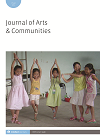- Home
- A-Z Publications
- Journal of Arts & Communities
- Previous Issues
- Volume 1, Issue 1, 2009
Journal of Arts & Communities - Volume 1, Issue 1, 2009
Volume 1, Issue 1, 2009
-
-
Song and the Presence of Absent Communities
More LessBy Iain BiggsThis essay is in two parts the first an academic argument, the second a loosely woven presentation of song lyric fragments and images that parallels concerns expressed in the first. The aim is to indicate why certain types of old, quasipagan songs might help a particular section of the population develop another sense of place and community. Using a distinction between metropolitan locals and the commitment of certain artists to an ethical identification with necessary limits inherent in community as understood by local cosmopolitans, I argue from greater attention to collective, communal, and social practices typified here by walking and song that are rooted in the lived realities and shared needs of ordinary people. I do so in the context of Edward S. Casey's claim that place, despite our assumption that it is a static entity, is best understood as an essay in experimental living within a changing culture. Declining to side either with phenomenologically-inclined promoters of enchantment or post-structural advocates of the primacy of absence, I seek to validate a particular and endless oscillation between these positions an oscillation I find performed in exemplary fashion by certain songs in their capacity to simultaneously enchant and to remember absence in the context of the animistic values of a now absent indigenous community.
-
-
-
The power to heal us with a smile and a song: Senior Well-being, Music-based Participatory Arts and the Value of Qualitative Evidence
More LessBy Elaine LallySweet Tonic is a singing-based participatory arts initiative based in the southwest of Sydney, Australia. This paper reports on a qualitative evaluation of the thirty-week workshop series. It provides qualitative evidence of the outcomes of the programme, linking these to recent debates about evidence-based policy approaches. It argues that, although Sweet Tonic is undoubtedly a beneficiary of the instrumentalist turn in arts policy, this framing also traps the programme into defining its success or failure in instrumentalist terms. It is suggested that, although such accounts are often dismissed as anecdotal, in fact the most powerful evidence of the impact of a programme like Sweet Tonic is contained in the accounts of personal experience of participants in the programme. It is therefore necessary to understand the complexities of evidence in cultural policy, and to develop new language to talk about evidence that doesn't unnecessarily privilege quantitative or statistical forms at the expense of qualitative evidence.
-
-
-
Improvising in Ruyang: Community Art as Ecological Practice
More LessThis study reports on the activities of the improvisation-based project TWIG, Together We Integrate Growth, which developed as a community initiative to facilitate ecological awareness through creative activities. It analyzes the TWIG Project as a model for practices of social, mental and natural ecology, as defined by Felix Guattari (2000) and in terms of its ability to use improvisation as a method for developing individual bodily perception and generating community interest in conservation of the local environment. Drawing parallels between TWIG's improvisatory programme and Michel de Certeau's notion of play as an act of political resistance, this article suggests that ecological practice necessarily engages multiple aspects of individuals, their communities, and the surrounding environment.
-
-
-
Puppetry as Community Arts Practice
More LessBy Matt SmithThis project/workshop report introduces the ways Matt Smith and PickleHerring Theatre approaches community puppetry. The report emphasizes the group experience, the participants' play and the levels of creativity in the workshops/projects. The efficacy of puppetry as an important form of community arts practice is given in the summary.
-
-
-
Talking the Game: A Case Study of an Oral Narrative Project with Professional Footballers
More LessBy Patrick RyanThis case study describes a storytelling residency running in over twenty professional football (soccer) clubs in England over the past eight years. Its practices and outcomes, to date, provide many points of interest for those practising or administrating community and educational arts projects. These, as well as the projects' future development, also provide academics with topics of further study.
-
-
-
Book Reviews
More LessCommunity Performance: An Introduction, Petra Kuppers (2007) Abingdon: Routledge, (238 pp.), ISBN: 978-0-415-39231-0, Paperback 19.99
-
-
-
Book Reviews
More LessAuthors: Jeanette Siddall and Mark WebsterAn Introduction to Community Dance Practice, Diane Amans (ed.) (2008), Palgrave Macmillan, (269 pp.), ISBN 978-0-230-55168-8, Hardback, 16.99, 978-0-230-55169-5, Paperback
Art, Community and Environment: Educational Perspectives, Glen Coutts and Timo Jokela (eds) (2008), Bristol: Intellect Books, (312 pp.), ISBN 978-1841501895, Hardback, 24.95
-
Most Read This Month

Most Cited Most Cited RSS feed
-
-
Why drawing, now?
Authors: Anne Douglas, Amanda Ravetz, Kate Genever and Johan Siebers
-
- More Less

